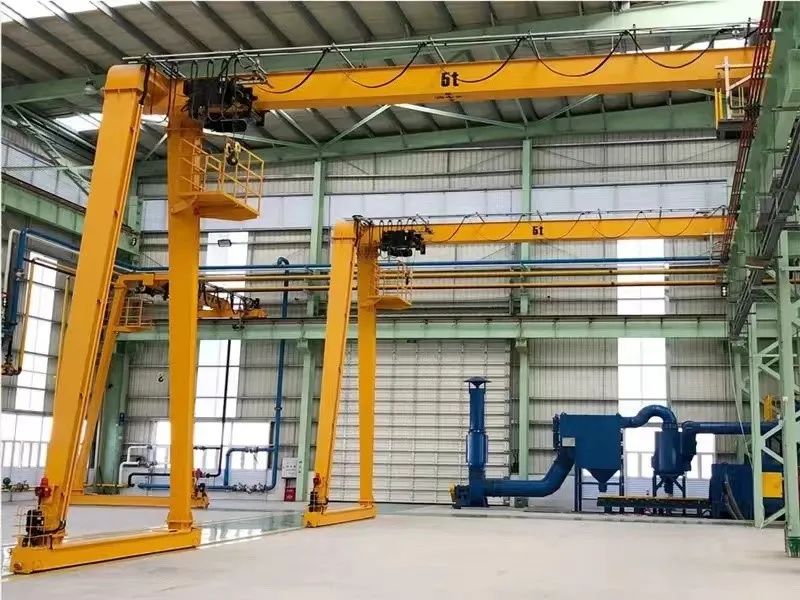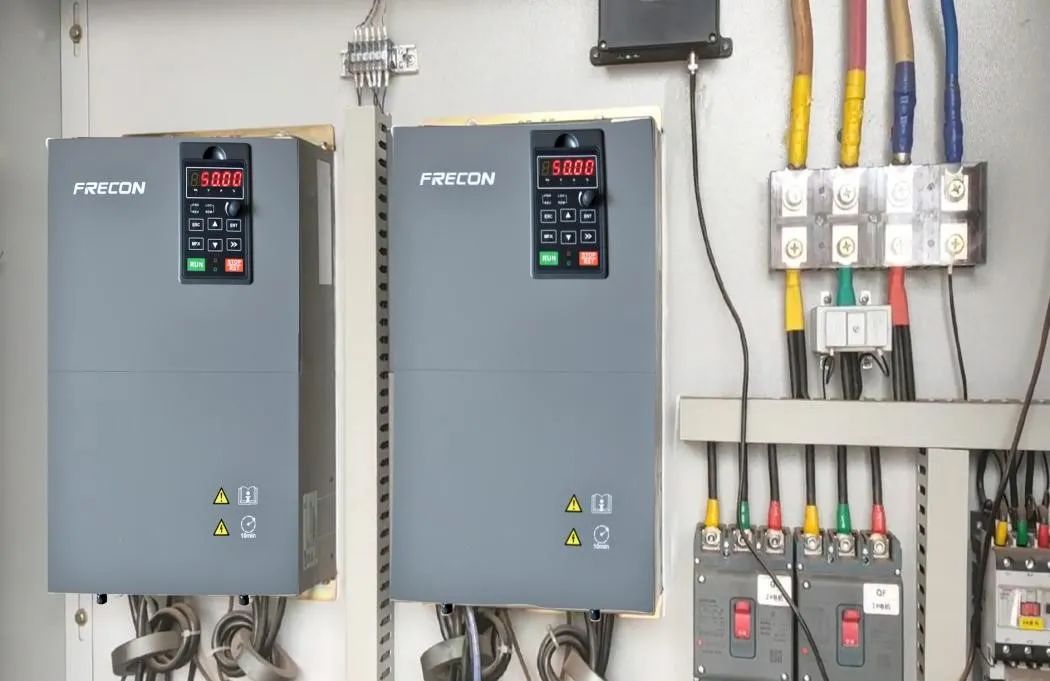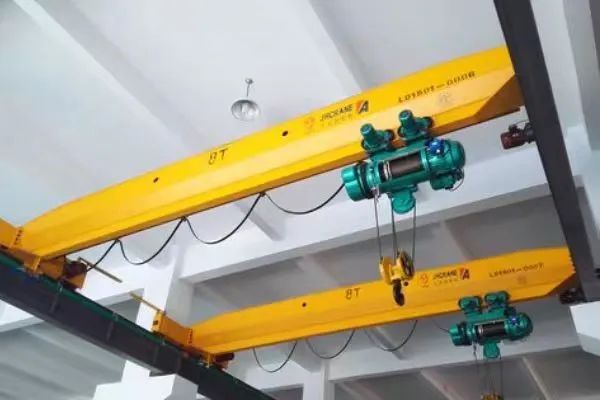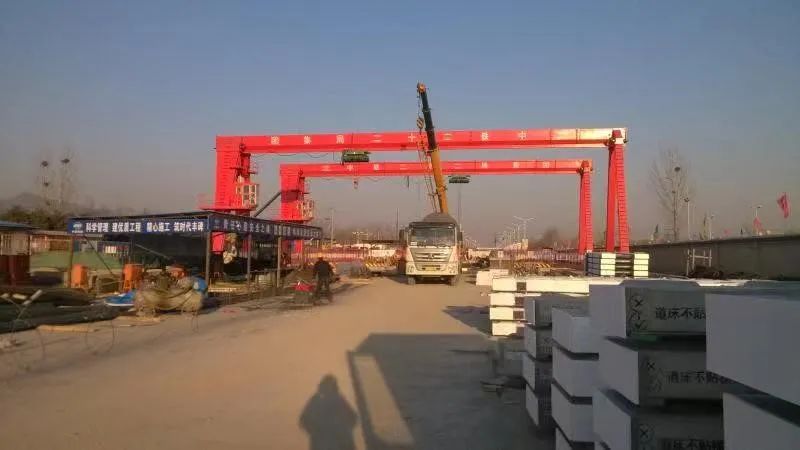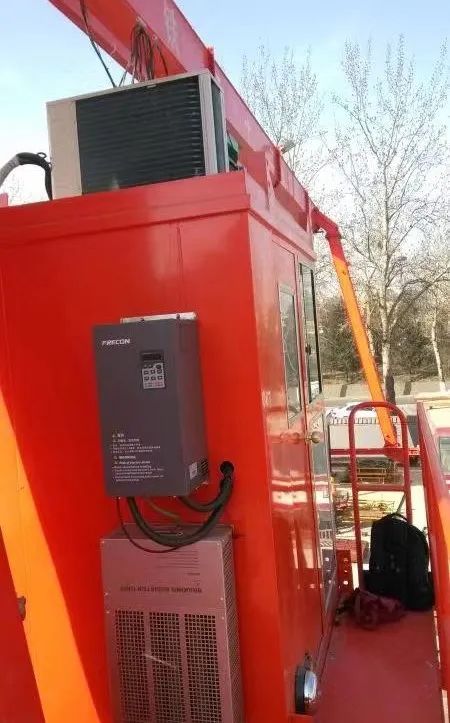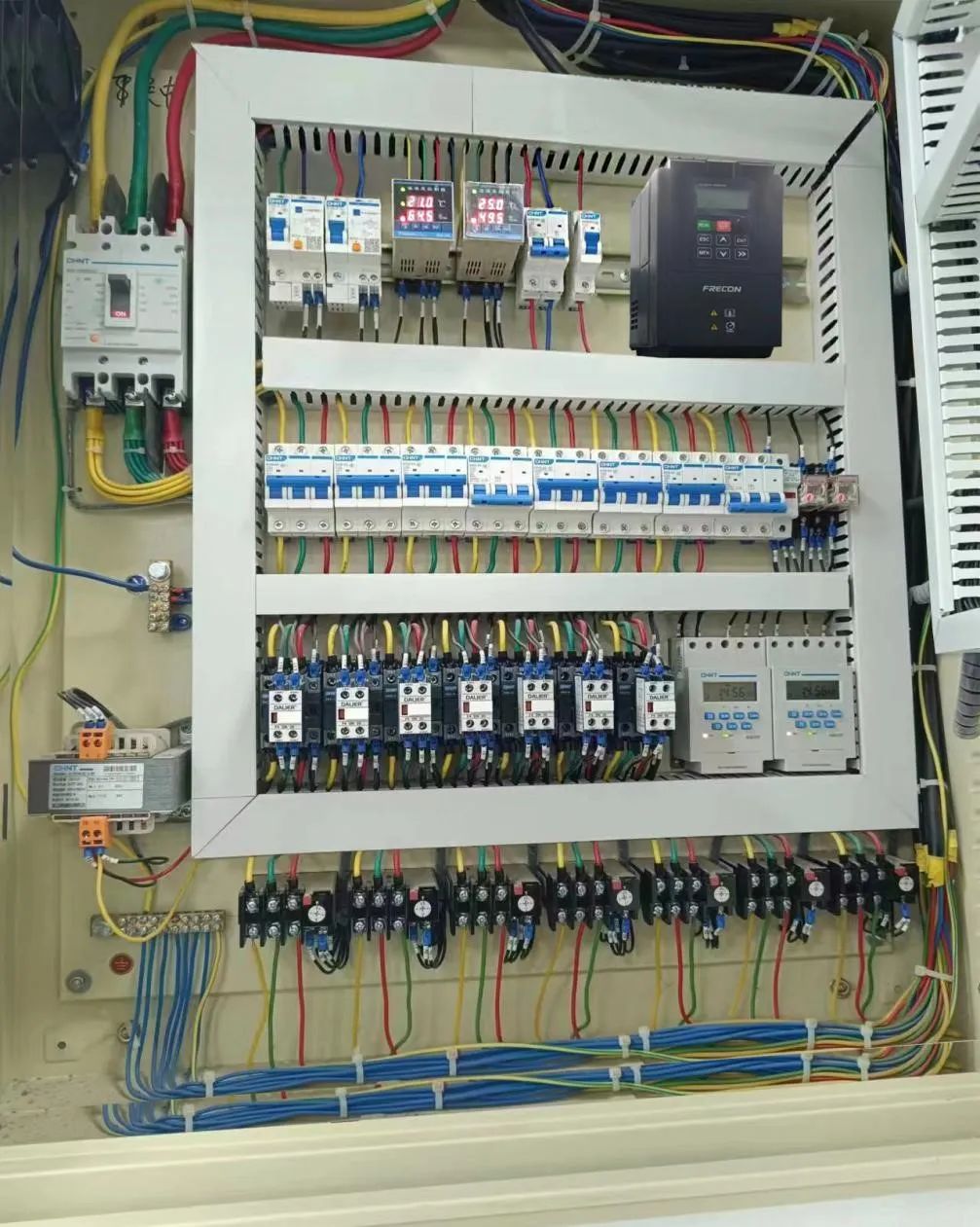1、Introduction
A crane is a versatile lifting equipment used for vertical lifting and horizontal transportation of heavy objects within a certain range. Types of overhead cranes include bridge cranes, specialized cranes, gantry cranes, and loading bridges. Mobile cranes include truck cranes, wheel-mounted cranes, crawler cranes, tower cranes, gantry cranes, floating cranes, and railway cranes. Cranes are essential construction equipment in modern high-rise construction. They play a crucial role, particularly in building construction and cargo handling, ensuring construction deadlines and safety, reducing costs, improving efficiency, and minimizing labor intensity.
Furthermore, the use of variable frequency drives (VFDs) in cranes offers several benefits. A VFD, as a speed control device, enables precise control of the crane's operating speed and torque according to specific requirements. Here are some advantages of using VFDs:
Energy efficiency: VFDs can intelligently adjust the motor's speed based on actual load demands, avoiding excessive energy consumption and optimizing energy utilization, thus saving energy costs.
Smooth startup: VFDs provide soft-start functionality, gradually increasing the motor's speed during the startup process. This reduces shocks and mechanical stresses, extending the crane's lifespan.
Precise control: VFDs offer precise speed and torque control, allowing for accurate adjustments of the crane's operating parameters as needed, improving operation precision and accuracy.
High-speed response: VFDs can quickly respond to operational commands, enabling rapid acceleration and deceleration of the crane, thus enhancing work efficiency and productivity.
By utilizing VFD technology, cranes can achieve higher performance, safer operations, and improved flexibility and controllability of work processes. These advantages make VFDs an indispensable key technology in the field of modern cranes.
2、Principle of variable frequency speed control
The basic principle of variable frequency speed control is based on the relationship between the speed of the AC motor, which is expressed as follows:
n=60f1(1-s)/p
where:
n--motor speed,
f1--power supply frequency,
p-number of motor poles,
s--slip ratio,s=(n1-n)/n1
n--synchronous motor speed.
By uniformly changing the stator power supply frequency f, the synchronous speed of the motor can be smoothly adjusted, achieving speed control operation.
In the variable frequency speed control system of a crane, a frequency inverter drives the motor, using open-loop U/f control, vector control, and closed-loop control. This means that based on the generated motor speed, the frequency is adjusted accordingly with the frequency of the power supply. The change in frequency will inevitably lead to a change in the motor's magnetic flux. To fully utilize the motor's iron core and maintain a constant magnetic flux, the ratio of voltage to frequency (U1/f1) must be kept constant (U1/f1=CΦm=constant). Frequency inverters using U/f control have a simple control circuit structure and lower cost, making them suitable for general-purpose applications with less demanding precision requirements.
3、The PLC variable frequency speed control system for the crane
The principle of the variable frequency speed control system for the crane is shown in Figure 4-1. The PLC sends control commands to the frequency inverter based on the position and speed signals of the hoist. The frequency inverter controls the power system of the crane according to these commands.
At the same time, when the variable frequency drive detects a fault, it sends a signal to the PLC. The PLC, based on the control commands, operates the protective relay that cuts off the power supply to protect the braking system of the crane's power system. This ensures a reliable and safe system.

Figure 4-1
4、Characteristics of the variable frequency drive
The FR500A/FR510A series vector control frequency inverters are primarily targeted at OEM customers in the mid-to-high-end market and specific applications that require heavy-duty loads. They are designed to be flexible and integrate FVC (FR510A), SVC, and VF control functions.
(1) Design Concept
The design concept focuses on improving flexibility to cater to various market applications, reducing the installation space required for the frequency inverter, and enhancing the overall thermal space within the electrical enclosure.
(2) Voltage Adaptability
The inverters are capable of adapting to a rated input voltage of three-phase 380 V with a tolerance range of -15% to +30%.
(3) Control Modes
The FR500A/FR510A series vector control frequency inverters offer multiple control modes, making them suitable for a wide range of applications that require high speed control accuracy, torque response speed, and low-frequency output characteristics. These control modes are designed to meet the specific demands of various application scenarios.
5、Performance Features
The FR510S inverter is an engineering servo drive specifically developed for high-speed spindles. It boasts a rich I/O interface and offers a wide speed range, fast response speed, and high control accuracy. In particular, it demonstrates remarkable features such as fast response speed (0.8 seconds for acceleration and deceleration to 25,000 RPM) and high control accuracy (error below 0.025% under closed-loop vector control, motor vibration speed below 0.2 mm/s), ensuring smooth op2eration of high-speed electric spindles.
Wide Speed Range: The inverter allows for accurate control and positioning requirements, enabling precise operations.
Soft Start and Stop: The soft start and stop function reduces mechanical transmission impact, significantly improving the load-bearing capacity of steel structures and extending the lifespan of cranes.
High Integration and Reliability: The inverter features high integration components and reliable low-voltage electrical devices, effectively solving complex wiring issues in the original electrical system. This not only reduces the probability of system failures but also facilitates maintenance.
Full Torque Output at Zero Speed: The motor can output full torque even at zero speed, ensuring system safety and reliability even in the event of loose or malfunctioning brakes, preventing heavy loads from sliding.
Rapid Dynamic Response: The inverter provides fast dynamic response, eliminating hook slipping and truly achieving "zero-speed crossover" functionality.
6、Introduction to the FR500A Series Frequency Inverters
(1) Wiring Schematic Diagram for FR500A
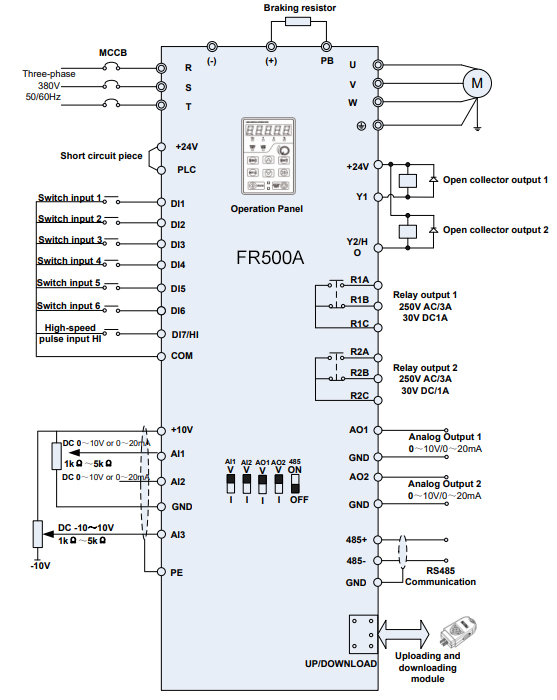
Figure 4-2
(2) Selection of Brake Resistor for the FR500A Series
When the variable frequency drive decelerates with a large inertial load or requires rapid deceleration, the motor operates in a regenerative state, transferring the load energy through the inverter's DC link, causing an increase in the bus voltage. If it exceeds a certain value, the variable frequency drive will trigger an over voltage fault and may even damage the internal power modules. To prevent this phenomenon, it is necessary to install a braking component.
The following are the recommended power and resistance values for the brake resistor. Depending on the load conditions, users can adjust the values appropriately, but they must remain within the recommended range.
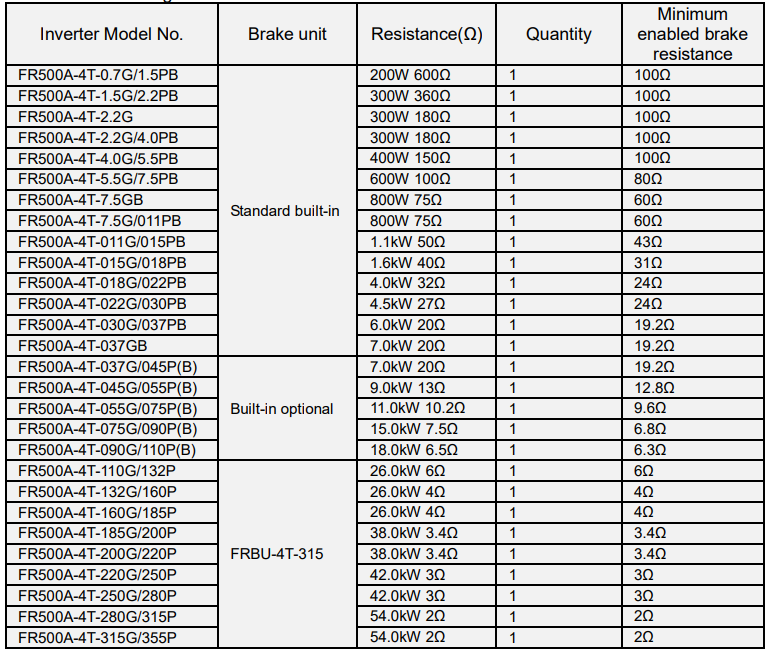
Figure4-3
7、Crane Variable Frequency Drive (VFD) Speed Control System Commissioning
(1) Commissioning of FR500A Variable Frequency Drive
After ensuring the correct wiring of the main circuit and control circuit, the system can be powered on for commissioning. Motor parameters are set through the operation panel of the variable frequency drive, and the motor is identified using the static self-learning method. After identification is completed, the control mode, output frequency, acceleration and deceleration time, relay DO output mode, brake release and lock detection frequency, and other corresponding parameters are set (for specific settings, please refer to the user manual of the respective variable frequency drive). Once the parameter settings are completed, according to the international experimental rules for cranes, several stages of commissioning will be conducted, including no-load commissioning, rated load commissioning, and 125% rated load commissioning. During commissioning, if there is slipping of the hook, the brake frequency can be appropriately increased, but it should not be set too high, as it may cause the variable frequency drive to malfunction. Generally, it is set within the range of 0.3 to 2 Hz.
(2) Parameters Table
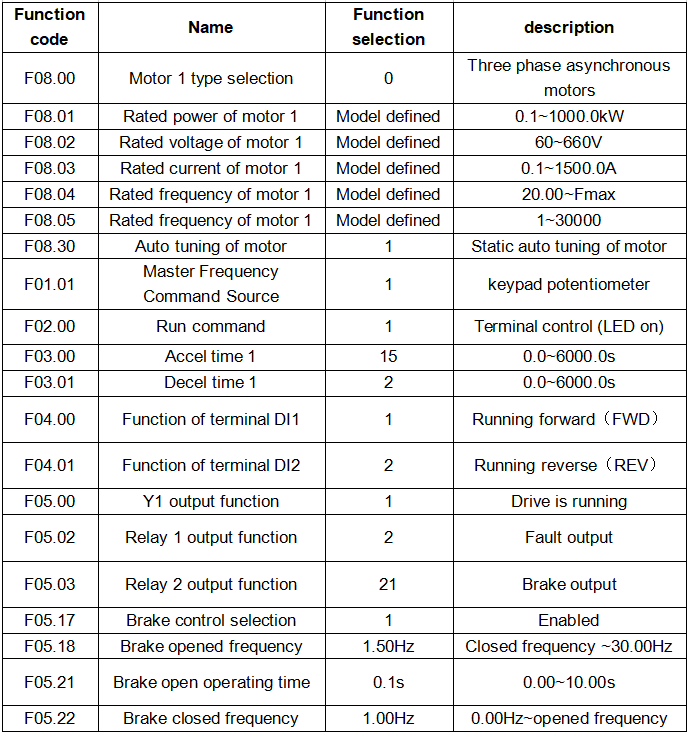
Figure 4-4
8、Crane Safety Commissioning
(1) Overload Testing and Anti-fall Testing
Safety is the most important criterion for elevators, and safety tests must be conducted according to national standards during system commissioning. During the no-load test, the upper and lower limits of the crane and the limit switches should be tested to ensure they operate according to design standards. After the 125% rated load commissioning, the overload protector should be adjusted to 110% for overload testing.
Anti-fall testing is usually performed with the installation of an anti-fall safety device on the crane. The anti-fall safety device is an important component of the crane and is relied upon to prevent accidents such as suction cup or hook falling. On construction sites, cranes must undergo a drop test every three months. The drop test can be performed by increasing the output frequency of the variable frequency drive to simulate the falling speed of the cage, and observing whether the anti-fall safety device activates.
(2) Stability Testing
During startup, attention should be paid to the stability of equipment shifting. It is necessary to ensure synchronous operation of the variable frequency drives, allowing the motors on both the left and right sides to move in a synchronized manner to prevent damage to the equipment caused by friction due to speed differences.
9、Crane site application pictures
